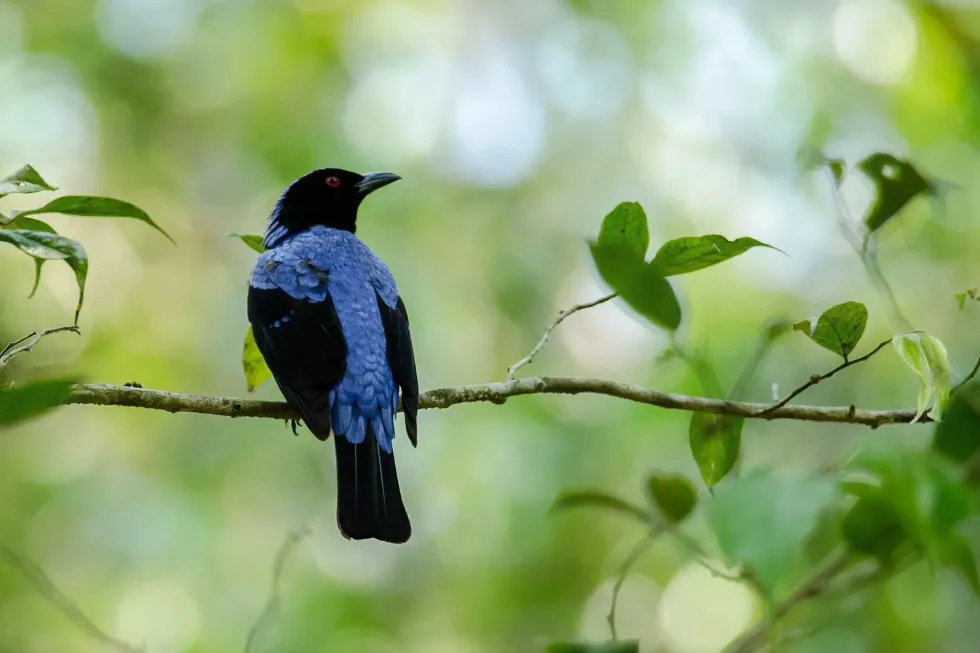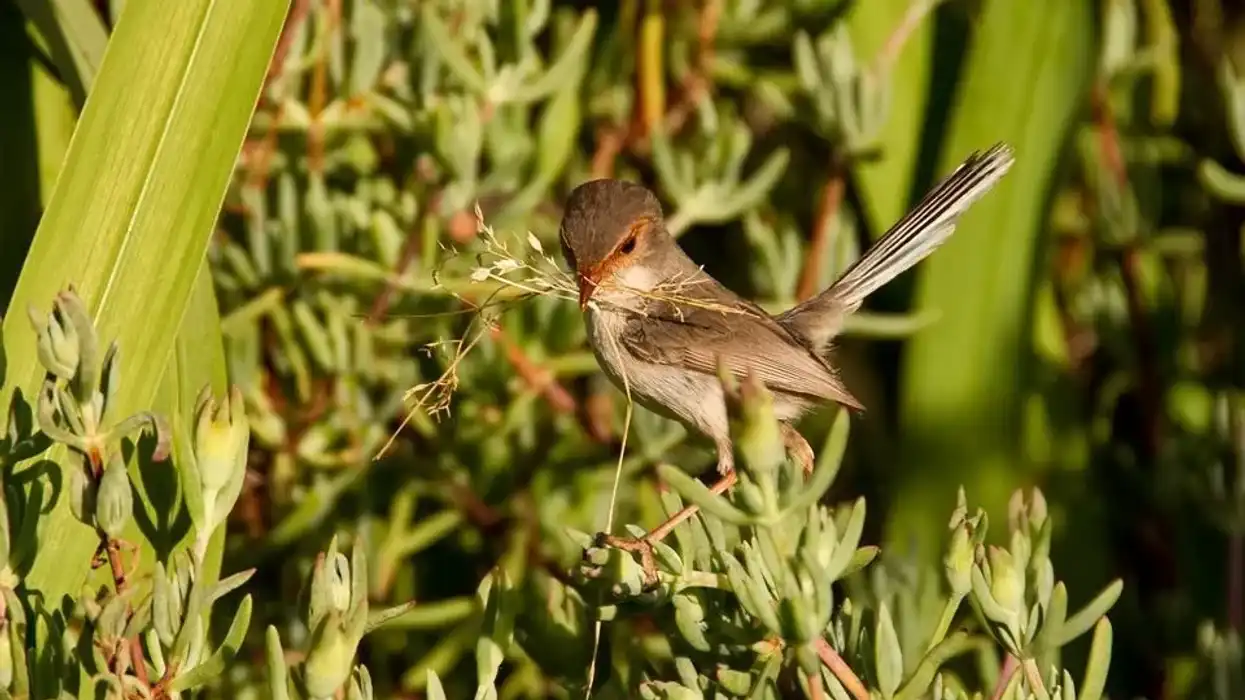Asian fairy-bluebirds (Irena puella) are widely distributed through tropical and subtropical southern Asia, whereas, as the name suggests, the Philippine fairy-bluebird (Irena cyanogastra) is endemic to the Philippines. These two species are the sole members of the genus Irena and are related to leafbirds and ioras.
The Philippine fairy-bluebird is sexually dimorphic, females have duller green plumage, whereas males have dark blue plumage. This species is a medium-sized bird found in lowlands and lower elevations of mountains. Philippine bluebirds are monogamous in nature, which means that these birds have only one partner during the breeding season.
If you liked these facts about the Philippine fairy bluebird, then you should see these facts about the blackpoll warbler and the American pipit too!
Philippine Fairy-Bluebird Interesting Facts
What type of animal is a Philippine fairy-bluebird?
The Philippine fairy-bluebird (Irena cyanogastra) is a bulbul-like bird found in the open forest.
What class of animal does a Philippine fairy-bluebird belong to?
The Philippine fairy bluebird belongs to the Aves class of animals and is a member of the Irenidae family.
How many Philippine fairy-bluebirds are there in the world?
There is no accurate count on the population of the Philippine fairy-bluebird.
As a result of the rapid change and decrease in Philippine fairy-bluebird habitat, these species are now listed as a Near Threatened among the two species of the genus Irena.
Where does a Philippine fairy-bluebird live?
This species is endemic to the Philippines.
The Philippine fairy-bluebird's range map includes Catanduanes, Bohol, Samar, Mindanao, Dinagat, Polillo, Basilan, Luzon, and Leyte. You can see these birds in closed-canopy lowland evergreen forests.
What is a Philippine fairy-bluebird's habitat?
The Philippine fairy-bluebird prefers to build its nests at least 16.5 ft (5 m) up in the furcated branches of the lower canopy and trees.
They build their nest on a rough platform and, to make this nest mostly thick, long twigs are used and then concealed by moss and roots with an open cup formed in the middle nest for the Philippine fairy-bluebird's eggs.
This species is subject to seasonal shifts as might be required for fig-eating species. It is unknown whether this species of Philippine fairy-bluebird migrates or not, but it is known that you cannot see any seasonal movement within their habitat range.
Who do Philippine fairy-bluebirds live with?
Philippine fairy bluebirds are monogamous and pair for life. Though these birds are seen together in a group of 30 individuals flying in search of figs in the forest, the Philippine fairy-bluebird male becomes especially territorial during the breeding season.
How long does a Philippine fairy-bluebird live?
A Philippine fairy-bluebird of the Irenidae family is known to live for six to seven years in the wild.
In captivity, these species may live up to nine years if provided a proper diet and favorable habitat.
How do they reproduce?
Both males and females of this species mature sexually when they are one year old. The breeding season begins from the month of March extending to the month of May, these birds are monogamous and pair for life.
Male fairy bluebirds become extremely territorial especially during the breeding season and to attract and bond with the female, it displays a courtship ritual that includes detailed vocalizations. Once the female Philippine fairy-bluebird accepts, she responds with approval by building a nest to lay her eggs.
The Philippine fairy-bluebird female lays two to three eggs in a single clutch that are olive, green to greenish-white in color, with a few brown splotches. Although females of this species build the nest and incubate the eggs themselves, males do not take part in incubation, they only provide food for the babies.
What is their conservation status?
The Philippine fairy-bluebird is listed as a Near Threatened species on the IUCN Red List, due to the continuous decline in their natural habitat range caused by deforestation.
Philippine Fairy-Bluebird Fun Facts
What do Philippine fairy-bluebirds look like?
We've been unable to source an image of a Philippine fairy-bluebird and have used an image of an Asian fairy-bluebird instead. If you are able to provide us with a royalty-free image of a Philippine fairy-bluebird, we would be happy to credit you. Please contact us at hello@kidadl.com.
Philippine fairy-bluebirds of the Irenidae family are distinguished by their elongated upper and more profound tail coverts that almost cover the entire tail. These birds have black feathers on the edge of their wings, chest, and face, with a blue crown strip, blackish-blue body, rump, wing patch, outer tail, and bright red eye.
How cute are they?
The small size and energetic black and blue color plumage make these birds extremely cute and mesmerizing to look at.
How do they communicate?
Philippine fairy-bluebirds of the Irenidae family are extremely noisy and they mostly communicate with series of calls. Especially during the breeding season, these birds become noisier and mimic a song to attract a female to pair with.
How big is a Philippine fairy-bluebird?
A Philippine fairy bluebird is a small bird in the Irenidae family that can grow up to 9.1-10.8 in (23.1–27.4 cm), these birds are slightly larger compared to the mountain bluebird and the western bluebird.
How fast can a Philippine fairy-bluebird fly?
The accurate speed of this bird, much like other members of the family Irenidae, cannot be stated due to the lack of specific data.
How much does a Philippine fairy-bluebird weigh?
Philippine fairy bluebirds are heavier than green parakeets and weigh up to 2.5-3.3 oz (70.8–93.5 g).
What are the male and female names of the species?
The male and female have no sex-specific names.
What would you call a baby Philippine fairy-bluebird?
Like many other birds, a baby Philippine fairy-bluebird is called a chick. A young chick has duller brown plumage which changes as they grow up.
What do they eat?
The Philippine fairy-bluebird of the Irenidae family is an omnivore and mostly consumes fruits, seeds, and small insects. This bird prefers figs as its main diet.
Are they dangerous?
No, these bluebirds are not dangerous at all. They are docile but become territorial and fight with other males during the breeding season.
Would they make a good pet?
No, this species would not make a good pet as these birds are listed as a Near Threatened species, which makes it illegal to keep them as pets and the other factor is that these are wild birds from the genus Irena and they would rather spend their time in a wild forest than in a cage.
So, if you were looking to this get this bird as a pet, it is recommended you stick to parrots!
Did you know...
Philippine fairy-bluebirds share two features with bulbuls which are the spot of hair-like feathers with no veins on the nape of the neck and the upper tail coverts, whereas the Philippine fairy-bluebird feather at the bottom tail is long and fluffy. The vocal skill of these birds is almost similar to that of bulbuls.
Philippine fairy-bluebirds were traditionally thought to be related to bulbuls but also have some qualities of drongos.
These birds play an important role in the wild as they keep a check on insect infestation and the dispersal of seeds.
Among the two species of fairy-bluebirds from the genus Irena, Philippine fairy-bluebirds have a strong, deep, and chiseled.
Why is it known as a Philippine fairy-bluebird?
The Philippine fairy-bluebird name is derived from their deep rich blue plumage and from the Tagalog people. These birds are considered as blessed by the Tagalog people as they are thought to be messengers of Bathala, the god of the native Tagalog. Fairy-bluebird is also generally used as a name for various other bird species of Irenidae.
According to Philippine mythology, the fairy bluebird was considered by the native Tagalog people to be an augural bird. It was believed that these birds were sent by Bathala to give hints to humankind whether they needed to advance on a journey or not.
If a passenger sees a fairy bluebird, and it moves from right to left, then it signifies approval to continue with the journey.
If a fairy bluebird moves from left to right, the passenger should not advance. However, there is, of course, no evidence to show that this is true.
What's unique about a Philippine fairy-bluebird?
The unique Philippine fairy-bluebird appearance is remarkable due to its extremely long lower and upper tail coverts giving an appearance of concealing its tail. These birds are considered sacred by many people living in the Philippines today and throughout history.
Here at Kidadl, we have carefully created lots of interesting family-friendly animal facts for everyone to discover! For more relatable content, check out these Senegal parrot facts and Cooper's hawk facts for kids.
You can even occupy yourself at home by coloring in one of our free printable lovebird coloring pages.










